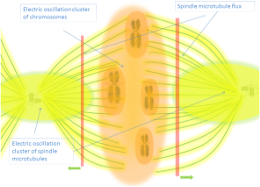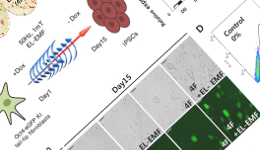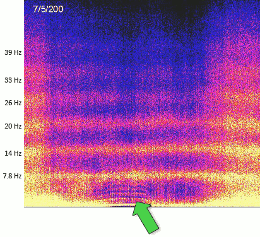

Electromagnetism & Microtubules
Those cellular constituents resonate electrically and generate information fields
This section focuses on the role of microtubules as generators and mediators of electromagnetic fields within cells. These findings are contextualized within broader discussions about cellular signaling, oscillatory dynamics, and potential implications for consciousness and morphogenetic fields. ...
Microtubules, composed of tubulin heterodimers, are structural and functional components of the cytoskeleton. Beyond their mechanical roles, they have emerged as dynamic bioelectronic systems capable of generating and responding to electromagnetic fields. These properties enable microtubules to act as information conduits within cells, influencing both local and systemic biological processes. This section explores their electromagnetic characteristics and examines their implications for higher-order functions, including the hypothesis of an electromagnetic mind.
Microtubules as Generators of Electromagnetic Fields
Microtubules are cytoskeletal structures composed of tubulin heterodimers arranged in a helical and axial periodicity. This structural organization enables them to act as biological antennas capable of generating coherent electromagnetic fields.
- Dipole Theory: Jiří Pokorný et al. (2021) propose that the electric dipoles within microtubules interact with external energy sources to generate coherent electromagnetic signals. This mechanism is supported by classical dipole theory, which explains how oscillations in microtubule lattices can produce space-time coherent fields.
- Inner Cavity Excitation: The inner cavity of microtubules plays a critical role in equalizing energy distribution. When supplied with energy, this cavity excites oscillators, including electrons at molecular orbitals, semiconducting bands, and conduction bands. Such excitation supports the hypothesis that microtubules function as nonlinear systems capable of spectral energy transfer, as predicted by Fröhlich's theory (Strupp, 2024; Idris, 2020).
Electrical Oscillations in Microtubules
Electrical oscillations are a hallmark feature of microtubular activity, with specific frequencies observed across various experimental setups.
- Fundamental Frequencies: Studies consistently report fundamental oscillatory frequencies around 39 Hz and 93 Hz in isolated microtubules, bundles, and sheets. For example:
- María del Rocío Cantero et al. (2020) demonstrated that voltage-clamped MT bundles exhibit prominent oscillations at 39 Hz under intracellular-like conditions.
- Brenda C. Gutierrez et al. (2020) found that isolated MTs display a broader spectrum of frequencies compared to structured MT complexes, suggesting that coherence increases with structural complexity.
- Gamma Frequency Range: The 39–40 Hz oscillations fall within the gamma frequency range (20–60 Hz), which is associated with higher cognitive functions such as attention, memory processing, and linguistic tasks. This overlap implies a potential link between microtubular oscillations and neural activity (Helfrich et al., 2019).
Propagation and Synchronization of Oscillations
The propagation of electrical oscillations along microtubules and their synchronization with other cellular components highlight their role in long-distance communication.
- Propagation Velocity: Experiments show that electrical oscillations propagate along the length of microtubules with velocities significantly higher than those observed in isolated MTs. Mirror images of oscillatory signals at both ends of neurites suggest efficient signal transmission (Cantero, M. R., et al., 2021b).
- Coherence and Entrainment: Structured MT complexes, such as bundles and sheets, tend to oscillate coherently at specific frequencies. This entrainment may facilitate synchronized recruitment of molecules and regulation of cellular processes, aligning with Fröhlich’s postulate of coherent excitations (Bandyopadhyay, 2020).
Functional Implications of Microtubular Electrodynamics
The electrodynamics of microtubules have profound implications for cellular physiology and beyond.
- Cell Division and Morphogenesis: Local electric fields generated by oscillating microtubules influence centrosome separation and spindle assembly during cell division. Motor proteins like kinesins and dyneins rely on proximity to MT structures for efficient force generation, underscoring the importance of MT-mediated electrical activity (Cantero, M. R., et al., 2021).
- Intracellular Transport and Signaling: Microtubules serve as conduits for ionic waves and nanopore-mediated conductance changes, contributing to intracellular transport and signaling pathways. These mechanisms may explain how microtubules regulate timing and coordination of neuronal firing (Komal Saxena et al., 2019).
Artificial Models and Wireless Communication
Recent advancements include the development of artificial microtubule-like devices to explore wireless communication mediated by magnetic fields.
- Noise-Driven Machines: Komal Saxena et al. (2019) demonstrated that artificial microtubules convert environmental noise into ordered magnetic signals. While these devices do not emulate the unique role of water crystals in natural microtubules, they provide insights into noise-driven communication mechanisms.
- Energy Harvesting: The ability of microtubules to harvest energy from ambient noise suggests a novel paradigm for bio-inspired technologies aimed at harnessing endogenous electromagnetic fields (Ghosh et al., 2014; Swain, 2006).
Broader Implications for Consciousness and Morphogenetic Fields
Although the primary focus of the reviewed studies is on microtubules' electromagnetic properties, their findings resonate with theories linking electromagnetic fields to consciousness and morphogenesis.
- Consciousness: The coherent oscillations generated by microtubules align with electromagnetic theories of consciousness, which posit that brain-wide EM fields integrate information to produce subjective experience (McFadden, 2021; Edwards, 2021).
- Morphogenetic Fields: Microtubules’ role in shaping cellular morphology and guiding developmental processes supports the concept of morphogenetic fields—spatially organized patterns of electromagnetic activity that direct tissue formation and regeneration (Ho, 2013; Rouleau & Levin, 2025).
Conclusion
The reviewed literature establishes microtubules as central players in the generation and modulation of electromagnetic fields within cells. Their ability to produce coherent oscillations, propagate signals, and synchronize cellular activities underscores their significance in both physiological and theoretical contexts. Future research should aim to elucidate the precise mechanisms underlying these phenomena and explore their applications in regenerative medicine, cancer therapy, and artificial intelligence.
References
- Bandyopadhyay, A. (2020). Self-similar triplet of triplet resonance frequency pattern in microtubules.
- Cantero, M. R., et al. (2020). Oscillatory dynamics in microtubule bundles.
- Cantero, M. R., et al. (2021). Bundles of Brain Microtubules Generate Electrical Oscillations.
- Cantero, M. R., et al. (2021b). Microtubule Electrical Oscillations and Hippocampal Function.
- Edwards, J. C. W. (2021). A Framework for Evolution and Consciousness: Panpsychism Without Tears?
- Ghosh, S., Aswani, K., Singh, S., Sahu, S., Fujita, D., & Bandyopadhyay, A. (2014). Design and construction of a brain-like computer: a new class of frequency-fractal computing using wireless communication in a supramolecular organic, inorganic system.
- Gutierrez, B. C., et al. (2020). Spectral analysis of isolated microtubules.
- Helfrich, R. F., Breska, A., & Knight, R. T. (2019). Neural entrainment and network resonance in support of top-down guided attention.
- Ho, M.-W. (2013). Life is Water Electric.
- Idris, Z. (2020). Quantum physics perspective on electromagnetic and quantum fields inside the brain.
- McFadden, J. (2021). The electromagnetic will.
- Pokorný, J. (2021). Dipole theory of microtubular electromagnetic field generation.
- Rouleau, N., & Levin, M. (2025). Brains and Where Else? Mapping Theories of Consciousness to Unconventional Embodiments [preprint].
- Saxena, K., et al. (2019). Artificial microtubules for noise-driven communication.
- Strupp, W. (2024). A new variant of the electromagnetic field theory of consciousness: approaches to empirical confirmation.
- Swain, J. (2006). On the possibility of large upconversions and mode coupling between Frohlich states and visible photons in biological systems.
Keywords
- Microtubules, Electromagnetic Fields, Oscillatory Dynamics, Gamma Frequency, Coherence, Fröhlich Condensation, Wireless Communication, Morphogenetic Fields
Very related sections:
↑ text updated (AI generated): 04/03/2025
↓ tables updated (Human): 21/12/2024
Endogenous Fields & Mind
 EM & Microtubules
EM & Microtubules
.
.

























